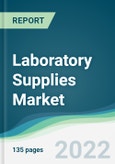The global laboratory supplies market is projected to grow at a CAGR of 7.44% over the forecast period, increasing from US$47.531 billion in 2025 to US$68.044 billion by 2030.
Laboratory supplies encompass a wide range of essential products utilized in scientific research, testing, and experimentation across various fields such as healthcare, pharmaceuticals, biotechnology, and education. These supplies include glassware and plasticware for measuring and mixing, consumables like gloves and lab coats for safety and hygiene, and chemical reagents necessary for experiments. Specialized instruments, such as microscopes, centrifuges, and spectrophotometers, are crucial for detailed analyses, while safety equipment like eyewash stations and fire extinguishers ensures a secure working environment. The laboratory supply market is expanding due to advancements in science and technology, along with increased research and development (R&D) activities. In the healthcare and pharmaceutical sectors, the rising demand for high-quality, specialized supplies - particularly in genomics, proteomics, and biotechnology - further drives the growth of this market. Additionally, the emphasis on laboratory automation and sustainability has led to the development of more efficient, eco-friendly, and cost-effective laboratory products.
Laboratory supplies encompass a wide range of essential products utilized in scientific research, testing, and experimentation across various fields such as healthcare, pharmaceuticals, biotechnology, and education. These supplies include glassware and plasticware for measuring and mixing, consumables like gloves and lab coats for safety and hygiene, and chemical reagents necessary for experiments. Specialized instruments, such as microscopes, centrifuges, and spectrophotometers, are crucial for detailed analyses, while safety equipment like eyewash stations and fire extinguishers ensures a secure working environment. The laboratory supply market is expanding due to advancements in science and technology, along with increased research and development (R&D) activities. In the healthcare and pharmaceutical sectors, the rising demand for high-quality, specialized supplies - particularly in genomics, proteomics, and biotechnology - further drives the growth of this market. Additionally, the emphasis on laboratory automation and sustainability has led to the development of more efficient, eco-friendly, and cost-effective laboratory products.
Key Drivers of the Laboratory Supplies Market
- Increasing Expenditure on Research & Development: According to data from the UNESCO Institute of Statistics, global R&D expenditure has reached approximately USD 1.7 trillion, with around ten countries accounting for 80% of this spending. As part of the Sustainable Development Goals (SDGs), nations have committed to significantly increasing both public and private R&D investments as well as the number of researchers by 2030. Continuous investments are being made to expand R&D facilities, particularly in life sciences worldwide. With rising healthcare expenditures and an increasing incidence of rare diseases, the life sciences industry faces pressure to expedite drug discovery and development processes. This demand is consequently driving the need for laboratory supplies globally.
- Government Investments in Education: Increased government funding aimed at enhancing the education sector is also contributing to the growth of research laboratories. For instance, the Canadian government allocated USD 763 million to the Canada Foundation for Innovation (CFI) over five years, with an additional USD 462 million per year starting in 2023-24. This funding supports researchers by investing in advanced laboratories and research equipment at Canadian universities, colleges, and research hospitals while fostering a new generation of researchers.
Reasons for buying this report:
- Insightful Analysis: Gain detailed market insights covering major as well as emerging geographical regions, focusing on customer segments, government policies and socio-economic factors, consumer preferences, industry verticals, other sub-segments.
- Competitive Landscape: Understand the strategic maneuvers employed by key players globally to understand possible market penetration with the correct strategy.
- Market Drivers & Future Trends: Explore the dynamic factors and pivotal market trends and how they will shape up future market developments.
- Actionable Recommendations: Utilize the insights to exercise strategic decision to uncover new business streams and revenues in a dynamic environment.
- Caters to a Wide Audience: Beneficial and cost-effective for startups, research institutions, consultants, SMEs, and large enterprises.
What do businesses use our reports for?
Industry and Market Insights, Opportunity Assessment, Product Demand Forecasting, Market Entry Strategy, Geographical Expansion, Capital Investment Decisions, Regulatory Framework & Implications, New Product Development, Competitive Intelligence.Report Coverage:
- Historical data & forecasts from 2022 to 2030
- Growth Opportunities, Challenges, Supply Chain Outlook, Regulatory Framework, Customer Behaviour, and Trend Analysis
- Competitive Positioning, Strategies, and Market Share Analysis
- Revenue Growth and Forecast Assessment of segments and regions including countries
- Company Profiling (Strategies, Products, Financial Information, and Key Developments among others)
The laboratory supplies market is segmented and analyzed as follows:
- By Offering
- Chemicals and Reagents
- Kits
- Consumables
- By End-User
- Government
- Life Sciences
- Industrial
- Others
- By Geography
- North America
- United States
- Canada
- Mexico
- South America
- Brazil
- Argentina
- Others
- Europe
- United Kingdom
- Germany
- France
- Spain
- Others
- Middle East and Africa
- Saudi Arabia
- UAE
- Israel
- Others
- Asia Pacific
- Japan
- China
- India
- South Korea
- Indonesia
- Thailand
- Others
- North America
Table of Contents
1. INTRODUCTION
2. RESEARCH METHODOLOGY
3. EXECUTIVE SUMMARY
4. MARKET DYNAMICS
5. LABORATORY SUPPLIES MARKET BY OFFERING
6. LABORATORY SUPPLIES MARKET BY END-USER
7. LABORATORY SUPPLIES MARKET BY GEOGRAPHY
8. COMPETITIVE ENVIRONMENT AND ANALYSIS
9. COMPANY PROFILES
Companies Mentioned
- Th. Geyer GmbH & Co. KG.
- Thermo Fisher Scientific
- Spectrum Chemical Manufacturing Corp.
- Ing. Petr Švec - PENTA s.r.o.
- Becton, Dickinson and Company
- Cardinal Health, Inc.
- Illumina, Inc.
- Bio-Rad Laboratories, Inc.
- Waters Corporation
- Cole-Parmer
Methodology

LOADING...
Table Information
| Report Attribute | Details |
|---|---|
| No. of Pages | 145 |
| Published | January 2025 |
| Forecast Period | 2025 - 2030 |
| Estimated Market Value ( USD | $ 47.53 Billion |
| Forecasted Market Value ( USD | $ 68.04 Billion |
| Compound Annual Growth Rate | 7.4% |
| Regions Covered | Global |
| No. of Companies Mentioned | 10 |









